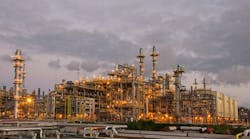The Middle East appears set to dominate the expansion of global refining capacity in the latter half of this decade, eclipsing Asia as projects there come on stream.
Prominent oil producers need new refining capacity as their demand for oil products grows, notes Soozhana Choi of Deutsche Bank AG in an Oct. 21 report.
According to Choi, nearly 5 million b/d of refining capacity will be built in the Middle East during 2010-18, representing more than 20% of global expansion during the period and boosting regional capacity by nearly 60%.
Saudi Arabia and Iran each plan to raise refining capacity by 1.2 million b/d through 2018. Other major expansions are nearly 900,000 b/d in Kuwait and 620,000 b/d in the UAE. A total of about 1.5 million b/d of the projected refining capacity expansion is in countries where elevated risks might keep plans from being fulfilled: Iraq, Iran, Yemen, and Bahrain.
Of secondary-unit capacities expected to be added in the region, the Deutsche Bank analysis says 40% will be desulfurization and 25% coking.
Among the region’s major oil producers, total country refining capacity eventually will exceed half of crude oil production capacity in Kuwait, Iran, and Qatar, lowering crude volumes available for export. In the UAE and Saudi Arabia, refining capacity will remain low relative to growing production capacity.
Those five countries account for nearly 25% of global oil production and 85% of Middle Eastern production.
Demand growth
The push to add refining capacity in the Middle East comes from “structurally strong demand growth rates and impending refined product shortages that have the potential to appear if refinery projects are not undertaken,” Choi says.
Oil demand growth in the Middle East is “far outpacing that of the US and Europe.” Gas oil-diesel accounts for about 30% of Middle Eastern consumption, gasoline about 25%.
Demand for fuel oil, declining elsewhere in the world, remains strong in the Middle East, driven by electrical power. About 36% of Middle Eastern power generation is fueled by oil, compared with an average 7% worldwide, according to International Energy Agency data cited by Choi.
Saudi Arabia is the main reason for the region’s heavy use of fuel oil. The kingdom relies on oil for nearly 60% of its power generation. Of the 20% of Saudi oil demand that applies to power generation, 39% is gas oil, 35% direct-burn crude, and 27% fuel oil.
“The gas oil, gasoline, and fuel oil balances on a long-term basis are dependent on the completion of all planned refinery projects,” Choi says. “The gasoline balance is most acutely vulnerable to delays or cancellations in expansions, given that the region is already starting off structurally short the motor fuel.” The region will remain a net exporter of jet fuel, especially to Europe.
Because Saudi Arabia will increase production capacity along with refining capacity, “its principal role in crude oil export markets will remain intact,” Choi says.

